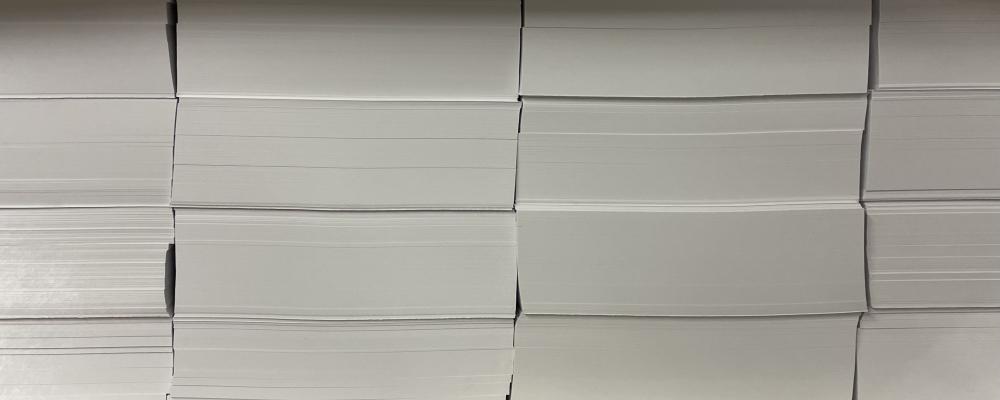
Selecting a Paper
Picking a paper is the first step towards receiving a quote and seeing your design come to life.
With the paper shortage, we advise being flexible and asking what is available when proceeding with a project before getting your heart set on a specific stock. If you want to know what your product will be made from, send us an email and then pop by to look at samples.
When thinking about construction, here a few big picture things to know.
Coated or Uncoated?
Coated paper is glossy and smooth while uncoated paper is often rougher and matte. Text documents stand out great on uncoated paper, think about the inside of a novel, whereas art heavy documents like magazines often rely on the shininess of coated paper to bring out rich colors.
Starting out with uncoated paper does not mean you are limited in textures. Various coatings can be added to paper after your printing is complete.
Soft touch laminate gives a velvet like texture to the paper, much like smooth suede. It is a matte laminate instead of glossy.
UV Coating is often used as a spot coating over logos, image sections, or cover headings. This is a hard, brilliant, clear gloss that stands out from the rest of the pages.
A varnish is a clear coat of gloss or matte over a page. A flood protects the entire page and is heavy bodied much like ink.
Aqueous coating is a high gloss coating that repels dirt, fingerprints, and smudges. This is often found on postcards and business cards that are held by many hands or stuck in handbags and wallets.
Text or cover stock?
Text paper is a thinner paper and more flexible. Flyers, mailers, book pages, and traditional copy paper are all text. A normal range for this is 50# - 100# paper.
Cover stock is thicker card paper. Instead of just being folded, it must be scored first to create a fine crease. It is more durable and often used for postcards, business cards, book covers, and invitations. This typically ranges from 60# - 120# paper.
If you are torn between a couple paper weights, ask us for a sample!
Some other things to consider:
What is the audience for this project?
Who and how many people will be touching this? Children’s books often need a thicker, glossier text to help with small hands and keeping pages pristine and showing the colors. Novels work well on thinner, uncoated paper because black ink stands out fine and adults are far less likely to nibble on their books.
Does this need to be die cut?
If a card has a detailed die cut or we are printing and punching out a box, we suggest a thicker paper. If the stock is too thin then the details could get lost or tiny edges wrinkled.
Will this be mailed, and to whom?
Mailing deserves its own article. Depending on what is being sent the paper should be adjusted but mail is priced by weight so keeping lighter is often the best idea.
Is this piece meant to have post production writing?
Uncoated paper and un-textured paper make a much easier surface for using all writing materials as the ink, graphite, or other material sticks better. If making something like a calendar it can be a tough call. Glossy paper is known for its depth of color and brilliance, but if you plan to write in pencil, it can be harder to leave a mark. Letterheads and notepads work best on uncoated.
